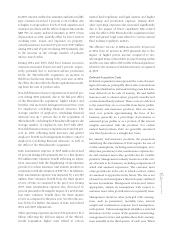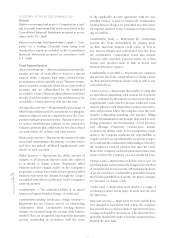American Express 2004 Annual Report Download - page 62
Download and view the complete annual report
Please find page 62 of the 2004 American Express annual report below. You can navigate through the pages in the report by either clicking on the pages listed below, or by using the keyword search tool below to find specific information within the annual report.
assumptions are changed, the percentage of estimated
gross profits or portion of interest margins used to
amortize DAC might also change. A change in the
required amortization percentage is applied retrospec-
tively; an increase in amortization percentage will
result in an increase in DAC amortization expense
while a decrease in amortization percentage will result
in a decrease in DAC amortization expense. The impact
on results of operations of changing assumptions with
respect to the amortization of DAC can be either posi-
tive or negative in any particular period and is reflected
in the period in which such changes are made. As a
result of these reviews, AEFA took actions in both 2004
and 2003 that impacted DAC balances and expenses.
In the third quarter 2004, these actions resulted in a net
$24 million DAC amortization expense reduction
reflecting: (i) a $27 million DAC amortization reduction
reflecting lower than previously assumed surrender
and mortality rates on variable annuity products,
higher surrender charges collected on universal and
variable universal life products and higher than previ-
ously assumed interest rate spreads on annuity and uni-
versal life products; (ii) a $3 million DAC amortization
reduction reflecting a change to the mid-term assumed
growth rate on variable annuity and variable universal
life products; and (iii) a $6 million DAC amortization
increase primarily reflecting a reduction in estimated
future premiums on variable annuity products.
In the third quarter 2003, these actions resulted in a net
$2 million DAC amortization expense reduction reflect-
ing: (i) a $106 million DAC amortization reduction
resulting from extending 10-15 year amortization peri-
ods for certain flex annuity products to 20 years based
on current measurements of meaningful life; (ii) a $92
million DAC amortization increase resulting from the
recognition of premium deficiency on AEFA’s long-
term care products; and (iii) a $12 million net DAC
amortization increase across AEFA’s universal life, vari-
able universal life and annuity products, primarily
reflecting lower than previously assumed interest rate
spreads, separate account fee rates and account main-
tenance expenses.
During the first quarter of 2004 and in conjunction with
the adoption of SOP 03-1, AEFA (1) established addi-
tional liabilities for insurance benefits that may become
payable under variable annuity death benefit guarantees
or on single pay universal life contracts, which prior to
January 1, 2004, were expensed when payable; and (2)
extended the time periods over which DAC associated
with certain insurance and annuity products are amor-
tized to coincide with the liability funding periods in
order to establish the proper relationships between
these liabilities and DAC associated with the same con-
tracts. As a result, AEFA recognized a $109 million charge
due to the previously discussed accounting change on
establishing the future liability under death benefit guar-
antees and recognized a $66 million reduction in DAC
amortization expense to reflect the lengthening of the
amortization periods for certain products impacted by
SOP 03-1.
DAC balances for various insurance, annuity and other
products sold by AEFA are set forth below:
December 31, (Millions) 2004 2003
Life and health insurance $ 1,766 $ 1,602
Annuities 1,872 1,734
Other 309 382
Total $ 3,947 $ 3,718
Impact of Market-Volatility on Results of Operations
Various aspects of AEFA’s business are impacted by
equity market levels and other market-based events.
Several areas in particular involve DAC and deferred
sales inducements, recognition of guaranteed mini-
mum death benefits (GMDB) and certain other variable
annuity benefits, asset management fees and structured
investments. The direction and magnitude of the
changes in equity markets can increase or decrease
amortization of DAC and deferred sales inducement
benefits, incurred amounts under GMDB and other
variable annuity benefit provisions and asset
management fees and correspondingly affect results of
operations in any particular period. Similarly, the value
of AEFA’s structured investment portfolios is impacted
by various market factors. Persistency of, or increases
in, bond and loan default rates, among other factors,
could result in negative adjustments to the market
values of these investments in the future, which
would adversely impact results of operations. See
AEFA’s Liquidity and Capital Resources section for a
further discussion of structured investments and con-
solidated derivatives.
Mutual Fund Industry Developments
As has been widely reported, the SEC, the National
Association of Securities Dealers, Inc. (NASD) and sev-
eral state attorneys general have brought proceedings
challenging several mutual fund industry practices,
including late trading, market timing, disclosure of rev-
enue sharing arrangements and inappropriate sales of
B shares. AEFA has received requests for information
concerning its practices and is providing information
and cooperating fully with these inquiries.
AXP
AR.04
60
Financial Review
























